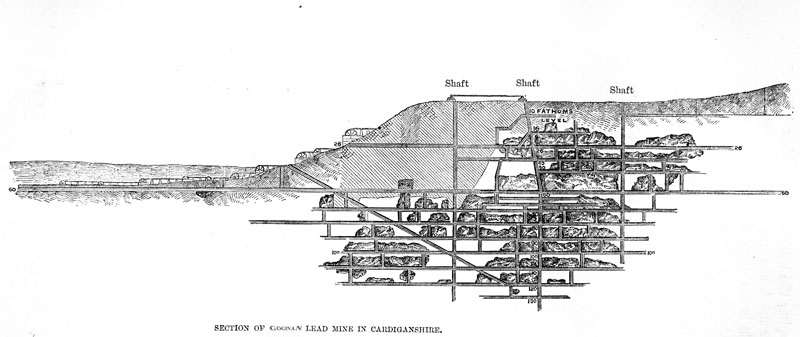
The village of Goginan is on the A44, seven miles west of Aberystwyth. The vein runs east-north-east, in Silurian and Ordovician grits, shales and mudstones, from Old Goginan village for two miles.
Already working in the late 16th century when the Society of Mines Royal took it over. It was under the latter’s auspices that Thomas Bushell worked there from 1640 and drove a number of adits. As a royalist, he was forced to quit the mine during the Civil War. It stood idle until the late 1660s when the Company for the Undertaking of Mines worked it along with Bwlch. Workings at this time are said to have reached a depth of 120 feet below the outcrop.
Under the Company of Mines Adventurers of England, between 1698 and 1708, William Waller cleaned out and enlarged some of Bushell’s adits as well as driving new ones. He worked Goginan and the nearby Bwlch, Bryn Pica, Pencraigddu mines, which all had a claimed silver content of 44 oz per ton. The company worked in this area until at least 1744.
For nearly a century the mine was worked spasmodically, with little or no development, until John Taylor & Co. acquired it in 1836. A measure of their success, shares issued at £5 in 1836 were worth £420 two years later. Even by 1850 they were worth £250. Shafts were sunk to 70 fathoms below the deepest adit, and an inclined haulage was driven from near the dressing floors to 60 fathoms below adit.
The 1860s closed with falling lead prices and the Taylors floated the Goginan Co. which worked Goginan between 1868 and 1875. Trading conditions continued to deteriorate four more times until 1886, when the mine closed.
Hughes, S.J.S. The Goginan Mines (British Mining No.35, 1988)
As well as being a lead mine Goginan is notable as a major producer of silver along with Darren and Cwmsymlog. This is in contrast to some other mines in the area where the word “silver” was included in the names of some of the 19th Century operators as an enticement to prospective shareholders.
It is impossible to date the earliest working, Roman working is a possibility but in the absence of any evidence of this we have to accept the Society of Mines Royal who took over mines in the area in 1583.
After the Mines Royal Act, it passed in to the hands of the Mine Adventurers, and then with the passing of time was eventually caught up in the mining frenzy of the 19th Century when John Taylor took over in 1836.
The mine is situated on steeply rising ground with a virtually continuous stream of water cascading down and running almost parallel with the mineral veins. The situation must have been viewed with glee by Taylor as at one time there were at least 12 waterwheels working on the site.
The real stroke of genius of Taylor was the sinking of a twin track incline which enabled the mine to be worked with intensity which was to return huge profits during this period.
This incline enabled ore trucks to be filled from the stope hoppers and raised to grass to discharge into the crusher hopper without any intermediate handling.
The success of this period of working was shortlived, but the mine struggled on through a succession of owners until it finally closed for good in 1926.
The ground levels off at the top of the site and this where the mines 2 pumping shafts are situate, Francis’s and Taylors. Today Taylors is blocked and Francis’s is only open for about 70 feet to a blockage.
Accessible underground workings are scant. The deep adit which was extended by cut and cover emerges close to the Melindwr road bridge, it is blocked by a telegraph pole some distance in, and backed up water in the workings suggests further blockages.
Taylors incline is open down to the water level but there are no accessible workings off, they all being below water. There are some interesting remains of the pulley mountings in the incline which in its initial period must have operated using chains.
The main accessible workings are the upper adit, the 26 fathom level, this passes through an underground quarry of impressive dimensions to a blockage at Francis’s Shaft. In January 2008 some members of Welsh Mines Society commenced a project to dig though this blockage, this was achieved in 2009 but only to discover the way ahead blocked by a solid ‘crush’ of fallen boulders, and extremely unsafe area.
The dig is currently progressing to attempt a way round this by circumventing a boulder the size of a van. Both the incline (to prevent dumping) and the 26 fathom (because of the ongoing project) are currently gated and locked.
Goginan Mine (Mindat.org)
Ref.: (in part): Rocks & Min.: 23:25. A Pb-Zn mine. The mine has almost been completely obliterated by “landscapeing”. The mine is considered to be very old, possibly pre-Roman. Roman coins have also been found on the site.
Recorded working starts from about 1620, when in was a Royal mine mostly developed for it’s silver content in the lead ore. It was further developed in the 1640’s by Thomas Bushell. In 1700 the mine was being worked by the Company of Mine Adventurers, this lasted untill 1744.
In 1836 the lease was taken up by John Taylor & Sons, although there may have been some work done befor this date. Goginan continued to be worked utill 1886. At various times the mine was worked with otheres in the near area.
Production figures are only avlible for the Taylor working, so could well be at least twice the record.
Goginan has been largely destroyed by uniformed landscaping.
25108 tons of lead ore
500000 ozs of silver (from lead ore)
Mineral List
‘Bindheimite’
Bournonite
Chalcopyrite
Galena
Gypsum
Quartz
Sphalerite
Tetrahedrite
Ullmannite
